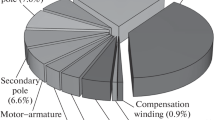Abstract
Some critical components in motors and generators have sliding electrical contacts. Electrical brushes are commonly used in those contact points to conduct current between the stationary and moving parts of a motor. Brushes are exposed both to mechanical and electrical loading. In this paper, studies on the wear of brushes against copper commutator were briefly reviewed. The main influential factors of brush wear are associated with both mechanical and electrical wear. Brush wear is affected by various factors including temperature, material properties, sliding speed, contact force, and interfacial and environmental conditions. The mechanical wear of brushes is proportional to the brush spring pressure and sliding speed, while the electrical wear of brushes is associated with current and contact voltage drop. To characterize the wear, a brush wear test machine was designed, and influential factors were measured such as electrical contact resistance, temperature, wear mass loss, and so on. The wear tests were processed using a small brush type automotive DC motor.
The main objective of this study is to investigate the effects of the wear behavior of copper-graphite brushes in a small brush-type DC motor. The variable conditions are with and without electrical current by changing the brush spring pressure and sliding speed, and the results are electrical contact resistance, voltage drop, brush surface temperature rise, and so on. Brush wear greatly changes with electrical current. This shows that the high current not only produces more Joule heating but also causes an increase in voltage drop, which will result in additional Joule heating.
Similar content being viewed by others
References
H. Zhongliang, C. Zhenhua, X. Jintong and D. Guoyun, Effect of PV factor on the wear of carbon brushes for micromotors, Wear, 265 (2008) 949–953.
I. Yasar, A. Canakci and F. Arslan, The effect of the brush spring pressure on the wear behaviour of copper-graphite brushes with electrical current, Tribology International, 40 (2007) 1381–1386.
Y. Feng, M. Zhang and Y. Xu, Effect of the electric current on the friction and wear properties of the CNT-Ag-G composites, Carbon 43 (2005) 2685–2692.
A. M. F. El-Refaie, M. M. Abdel Aziz, S. A. Y. Khorshid and E. E. M. Abu Elzahab, Effect of combined velocity and pressure on life time of carbon brushes, IEEE Transactions on energy conversion 15(2) (2000) 176–180.
D. H. He and R. Manory, A novel electrical contact material with improved self-lubrication for railway current collectors, Wear (249) (2001) 626–636.
J. A. Greenwood, Constriction resistance and the area of real contact, Br. J. Appl. Phys. (17) (1966) 1621–1631.
M. D. Bryant, J. P. Wang and J. W. Lin, Thermal mounding in high speed dry sliders: experiment, theory and comparison, Wear (181–183) (1994) 668–677.
Z. L. Hu, Z. H. Chen and J. T. Xia, Study on surface film in the wear of electrographite brushes against copper commutators for variable current and humidity, Wear (264) (2008) 11–17.
Author information
Authors and Affiliations
Corresponding author
Additional information
Wae-Gyeong Shin is currently a Ph.D. candidate at the School of Mechanical Engineering at Yonsei University in Seoul, Korea. She works with materials properties and electronic parts of automotives and reliability engineering at the Korea Automotive Technology Institute in Chonan, Korea.
Soo-Hong Lee is currently working as a full professor in Department of Mechanical Engineering at Yonsei University in Seoul, Korea. He received his bachelor degree in Mechanical Engineering at Seoul National University in 1981 and masters in Mechanical Engineering Design at Seoul National University in 1983 as well. He obtained his Ph.D degree from Stanford University, California, USA in 1991. His current research interests include Intelligent CAD, Knowledge-based Engineering Design, CE(Concurrent Engineering), PDM (Product Design Management), PLM(Product Lifecycle Management), Artificial Intelligence in Design and DA(Design Automation).
Rights and permissions
About this article
Cite this article
Shin, WG., Lee, SH. An analysis of the main factors on the wear of brushes for automotive small brush-type DC motor. J Mech Sci Technol 24, 37–41 (2010). https://doi.org/10.1007/s12206-009-1135-4
Received:
Revised:
Accepted:
Published:
Issue Date:
DOI: https://doi.org/10.1007/s12206-009-1135-4




